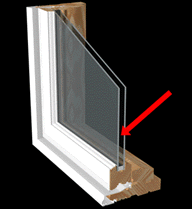window gas fill
Insulated windows or glazing units may have a special gas injected between the panes to reduce the conductance between the glass layers. Originally, this space was filled with air or flushed with dry nitrogen just prior to sealing. In a sealed glass insulating unit, air currents between the two panes of glazing carry heat to the top of the unit and settle into cold pools at the bottom. Filling the space with a less conductive, more viscous, or slow-moving gas minimizes the convection currents within the space, conduction through the gas is reduced, and the overall transfer of heat between the inside and outside is reduced.
 |
Manufacturers have introduced the use of argon and krypton gas fills, with measurable improvement in thermal performance. These gases are inert, i.e don't react with other substances, and have a higher resistance to heat flow than air, so that they decrease a window's U-value. Argon is inexpensive, nontoxic, nonreactive, clear, and odorless. The optimal spacing for an argon-filled unit is the same as for air, about 1/2 inch (11-13 millimeters). Krypton has better thermal performance, but is more expensive to produce. Krypton is particularly useful when the space between glazings must be thinner than normally desired, for example, 1/4 inch (6 millimeters). The optimum gap width for krypton is 3/8" (9 millimeters). A mixture of krypton and argon gases is also used as a compromise between thermal performance and cost.
